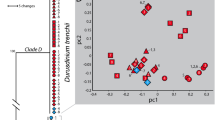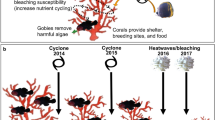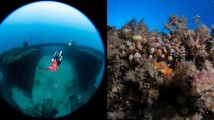Abstract
Mass coral bleaching events caused by elevated seawater temperatures1,2 have resulted in extensive coral mortality throughout the tropics over the past few decades3,4. With continued global warming, bleaching events are predicted to increase in frequency and severity, causing up to 60% coral mortality globally within the next few decades4,5,6. Although some corals are able to recover and to survive bleaching7,8, the mechanisms underlying such resilience are poorly understood. Here we show that the coral host has a significant role in recovery and resilience. Bleached and recovering Montipora capitata (branching) corals met more than 100% of their daily metabolic energy requirements by markedly increasing their feeding rates and CHAR (per cent contribution of heterotrophically acquired carbon to daily animal respiration), whereas Porites compressa (branching) and Porites lobata (mounding) corals did not. These findings suggest that coral species with high-CHAR capability during bleaching and recovery, irrespective of morphology, will be more resilient to bleaching events over the long term, could become the dominant coral species on reefs, and may help to safeguard affected reefs from potential local and global extinction.
This is a preview of subscription content, access via your institution
Access options
Subscribe to this journal
Receive 51 print issues and online access
$199.00 per year
only $3.90 per issue
Buy this article
- Purchase on Springer Link
- Instant access to full article PDF
Prices may be subject to local taxes which are calculated during checkout


Similar content being viewed by others
References
Glynn, P. Coral reef bleaching: facts, hypotheses and implications. Global Change Biol. 2, 495–509 (1996)
Jokiel, P. L. & Coles, S. L. Response of Hawaiian and other Indo-Pacific reef corals to elevated temperature. Coral Reefs 8, 155–162 (1990)
Hughes, T. P. et al. Climate change, human impacts, and the resilience of coral reefs. Science 301, 929–933 (2003)
Hoegh-Guldberg, O. Climate change, coral bleaching and the future of the world's coral reefs. Mar. Freshwat. Res. 50, 839–866 (1999)
Wilkinson, C. Status of Coral Reefs of the World: 2000 (Australian Institute for Marine Science, Townsville, 2000)
Buddemeier, R. W., Kleypas, J. A. & Aronson, R. B. Coral Reefs & Global Climate Change: Potential Contributions of Climate Change to Stresses on Coral Reef Ecosystems (Pew Center on Global Climate Change, Arlington, Virginia, 2004)
Wilkinson, C. & Hodgson, G. Coral reefs and the 1997–1998 mass bleaching and mortality. Nature & Resources 35, 16–25 (1999)
Loya, Y. et al. Coral bleaching: the winners and the losers. Ecol. Lett. 4, 122–131 (2001)
Moberg, F. & Folke, C. Ecological goods and services of coral reef ecosystems. Ecol. Econ. 29, 2151–2233 (1999)
Glynn, P. W., Mate, J. L., Baker, A. C. & Calderon, M. O. Coral bleaching and mortality in Panama and Ecuador during the 1997–1998 El Nino Southern Oscillation event: spatial/temporal patterns and comparisons with the 1982–1983 event. Bull. Mar. Sci. 69, 79–109 (2001)
Stimson, J., Sakai, K. & Sembali, H. Interspecific comparison of the symbiotic relationship in corals with high and low rates of bleaching-induced mortality. Coral Reefs 21, 409–421 (2002)
Rowan, R. Thermal adaptation in reef coral symbionts. Nature 430, 742 (2004)
Baker, A. C. Reef corals bleach to survive change. Nature 411, 765–766 (2001)
Fitt, W. K., McFarland, F. K., Warner, M. E. & Chilcoat, G. C. Seasonal patterns of tissue biomass and densities of symbiotic dinoflagellates in reef corals and relation to coral bleaching. Limnol. Oceanogr. 45, 677–685 (2000)
Grottoli, A. G., Rodrigues, L. J. & Juarez, C. Lipids and stable carbon isotopes in two species of Hawaiian corals, Porites compressa and Montipora verrucosa, following a bleaching event. Mar. Biol. 145, 621–631 (2004)
Porter, J. W., Fitt, W. K., Spero, H. J., Rogers, C. S. & White, M. W. Bleaching in reef corals: physiological and stable isotopic responses. Proc. Natl Acad. Sci. USA 86, 9342–9346 (1989)
Muscatine, L., McCloskey, L. R. & Marian, R. E. Estimating the daily contribution of carbon from zooxanthellae to coral animal respiration. Limnol. Oceanogr. 26, 601–611 (1981)
Szmant, A. M. & Gassman, N. J. The effects of prolonged ‘bleaching’ on the tissue biomass and reproduction of the reef coral Montastrea annularis. Coral Reefs 8, 217–224 (1990)
Ward, S., Harrison, P. J. & Hoegh-Guldberg, O. Coral bleaching reduces reproduction of scleractinian corals and increases susceptibility to future stress. Proc. 9th Int. Coral Reef Symp. 2, 1123–1128 (2000)
Lesser, M. P. Oxidative stress causes coral bleaching during exposure to elevated temperatures. Coral Reefs 16, 187–192 (1997)
Jeffrey, S. W. & Humphrey, G. F. New spectrophotometric equations for determining chlorophylls a, b, c1 and c2 in higher plants, algae and natural phytoplankton. Biochem. Physiol. Pflanz. 167, 191–194 (1975)
Dubois, M., Giles, K. A., Hamilton, J. K., Rebers, P. A. & Smith, F. Colorimetric method for determination of sugar and related substances. Anal. Chem. 28, 350–356 (1956)
Smith, P. K. et al. Measurement of protein using bicinchoninic acid. Anal. Biochem. 150, 76–85 (1985)
SAS/STAT Software Version 8.02 (SAS Institute, Cary, North Carolina, 1999–2001).
Palardy, J. E., Grottoli, A. G. & Matthews, K. A. Effects of upwelling, depth, morphology and polyp size on feeding in three species of Panamanian corals. Mar. Ecol. Prog. Ser. 300, 79–89 (2005)
Palardy, J. E., Grottoli, A. G. & Matthews, K. A. Effect of naturally changing zooplankton concentrations on feeding rates of two coral species in the Eastern Pacific. J. Exp. Mar. Biol. Ecol. 331, 99–107 (2006)
Heidelberg, K. B., Sebens, K. P. & Purcell, J. E. Composition and sources of near reef zooplankton on a Jamaican forereef along with implications for coral feeding. Coral Reefs 23, 263–280 (2004)
Houlbrèque, F., Tambutté, E., Richard, C. & Ferrier-Pagès, C. Importance of a micro-diet for scleractinian corals. Mar. Ecol. Prog. Ser. 282, 151–160 (2004)
Acknowledgements
We thank the Hawaii Institute of Marine Biology and P. Jokiel for local assistance; M. Lesser for the use of metabolism chambers and for comments; T. Pease for advice on lipid extractions; P. Petraitis for statistical advice; R. Langston for plankton collections; J. Bauer, D. Gleason and D. Alsdorf for comments; L. M. Grottoli for editorial assistance; and the University of Pennsylvania. Funding was provided by the Mellon Foundation (to A.G.G.), William Penn Fellowship (to L.J.R.), the Chemical Oceanography Program of the US National Science Foundation (to A.G.G.), and the Biological Oceanography Program of the US National Science Foundation (to A.G.G.). Author Contributions All authors contributed equally to this work.
Author information
Authors and Affiliations
Corresponding author
Ethics declarations
Competing interests
Reprints and permissions information is available at npg.nature.com/reprintsandpermissions. The authors declare no competing financial interests.
Supplementary information
Supplementary Data
This file contains a description and a Supplementary Table of general ANOVA statistical results. (DOC 55 kb)
Rights and permissions
About this article
Cite this article
Grottoli, A., Rodrigues, L. & Palardy, J. Heterotrophic plasticity and resilience in bleached corals. Nature 440, 1186–1189 (2006). https://doi.org/10.1038/nature04565
Received:
Accepted:
Issue Date:
DOI: https://doi.org/10.1038/nature04565
This article is cited by
-
Host starvation and in hospite degradation of algal symbionts shape the heat stress response of the Cassiopea-Symbiodiniaceae symbiosis
Microbiome (2024)
-
Year-round variations in reserve lipid molecular species of the Indo-Pacific corals Sinularia flexibilis and Millepora platyphylla
Coral Reefs (2024)
-
Holobiont responses of mesophotic precious red coral Corallium rubrum to thermal anomalies
Environmental Microbiome (2023)
-
Reef-building corals farm and feed on their photosynthetic symbionts
Nature (2023)
-
Similarities in biomass and energy reserves among coral colonies from contrasting reef environments
Scientific Reports (2023)
Comments
By submitting a comment you agree to abide by our Terms and Community Guidelines. If you find something abusive or that does not comply with our terms or guidelines please flag it as inappropriate.



